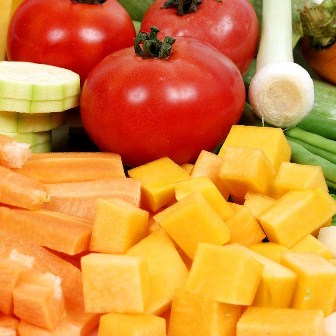A Vegetable of a Different Color
01 June 2011By Chef Colin Roche, MBA, CEC, CCE, FMP, CHE
 Plants often have beautiful colors that add interest and appeal to meals. Their pigments, however, are affected by acid and alkaline, so care should be taken to cook them properly.
Plants often have beautiful colors that add interest and appeal to meals. Their pigments, however, are affected by acid and alkaline, so care should be taken to cook them properly.
Here is an experiment you can do in your culinary labs to show students the effects of acid and alkaline on vegetable pigment.
The Lesson: “Alkalis / Acid Experiment”
Directions: Break the class into groups and have them gather the following vegetables. (Instructor should demonstrate how to prep each product.)
- GROUP #1 1 head Cauliflower
- GROUP #2 1 lb. Carrots
- GROUP #3 1 head Red Cabbage
- GROUP #4 1 bunch Asparagus
- GROUP #5 4 each Beets
- GROUP #6 1 head Broccoli
Then have each group divide its vegetables into thirds and cook as follows:
- 1/3 cooked in plain boiling salted water.
- 1/3 cooked in acidulated water. (Add 2 oz. of vinegar to the boiling salted water)
- 1/3 cooked in alkali water. (Add 2 Tbsp. of baking soda to the boiling salted water)
When cooked, shock the vegetables and place into labeled containers identifying what they were cooked in. When all groups have finished, gather students to evaluate and discuss the results.
Results/Outcomes
CHLOROPHYLL is the pigment found in green vegetables.
- Plain Water: Tap water affects chlorophyll by intensifying the green color since tap water is usually slightly alkaline.
- Acid: Acid turns the green colors to a dull olive green; therefore, do not cook vegetables with acid.
- Alkaline: Alkaline intensifies the green; however, it destroys vitamins and makes vegetables mushy; therefore, it is not recommended.
CAROTENOID is the pigment that provides the orange color in vegetables. It also includes lycopene, which provides the red in tomatoes and watermelon, as well as Xanthophyll, which provides the yellow color in corn.
- Plain Water: Tap water retains the pigments and is an acceptable way to cook these vegetables. However, overcooking will diminish the amount of color, so cook as short as possible.
- Acid: Acid decreases the pigment and prevents tenderness. Best to cook in plain water and then add any desired acid at the end of cooking.
- Alkaline: Alkaline intensifies this pigment, making it brighter and darker. However, it also makes it mushy, so avoid.
ANTHOCYANIN is the red to blue pigment found in fruits and vegetables.
- Plain Water: Tap water turns a plant’s color from its normal hue to a dull and unappetizing blue, and is therefore not recommended.
- Acid: Acid intensifies the red color, although, because it firms, it is often not added until the end of the cooking.
- Alkaline: Alkaline turns the color to an unappetizing green/blue-green and is never recommended.
ANTHOXANTHIN is the white to yellow pigment found in vegetables.
- Plain water: The preferred method to cook this color vegetable; however, overcooking some types (turnips and cauliflower) can turn them pinkish.
- Acid: An acid is often added during the last half of the cooking period to maintain a bright white color; however, adding the acid too early in the cooking process can make the vegetable too firm.
- Alkali: Alkali turns the color somewhat yellowish and the texture to mush; therefore, you want to avoid.
Colin Roche, MBA, CEC, CCE, FMP, CHE, is department chair at the College of Culinary Arts at the North Miami campus of Johnson & Wales University, as well as an assistant professor teaching a variety of culinary and hospitality courses.
Photo: © Ramon Grosso | Dreamstime.com, http://www.dreamstime.com/free-stock-image-vegetables-rimagefree1653598-resi1793763
